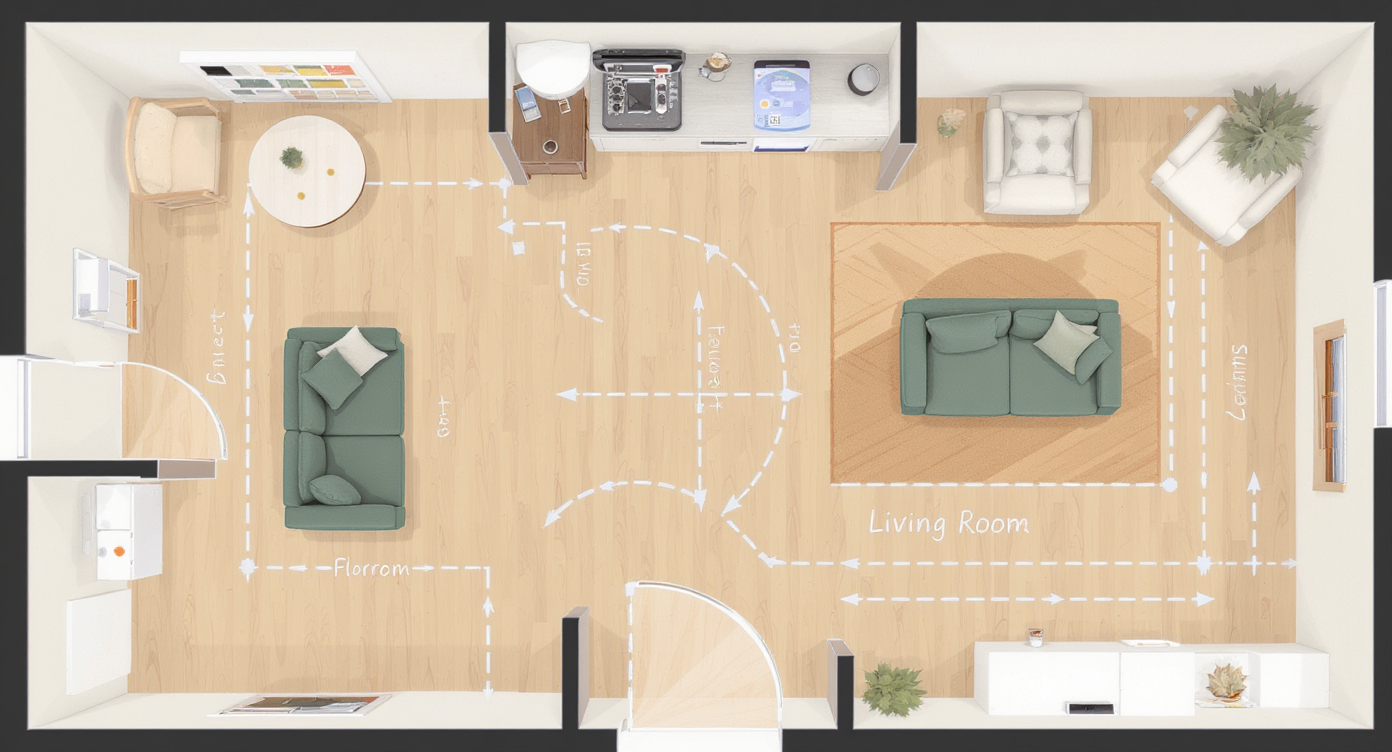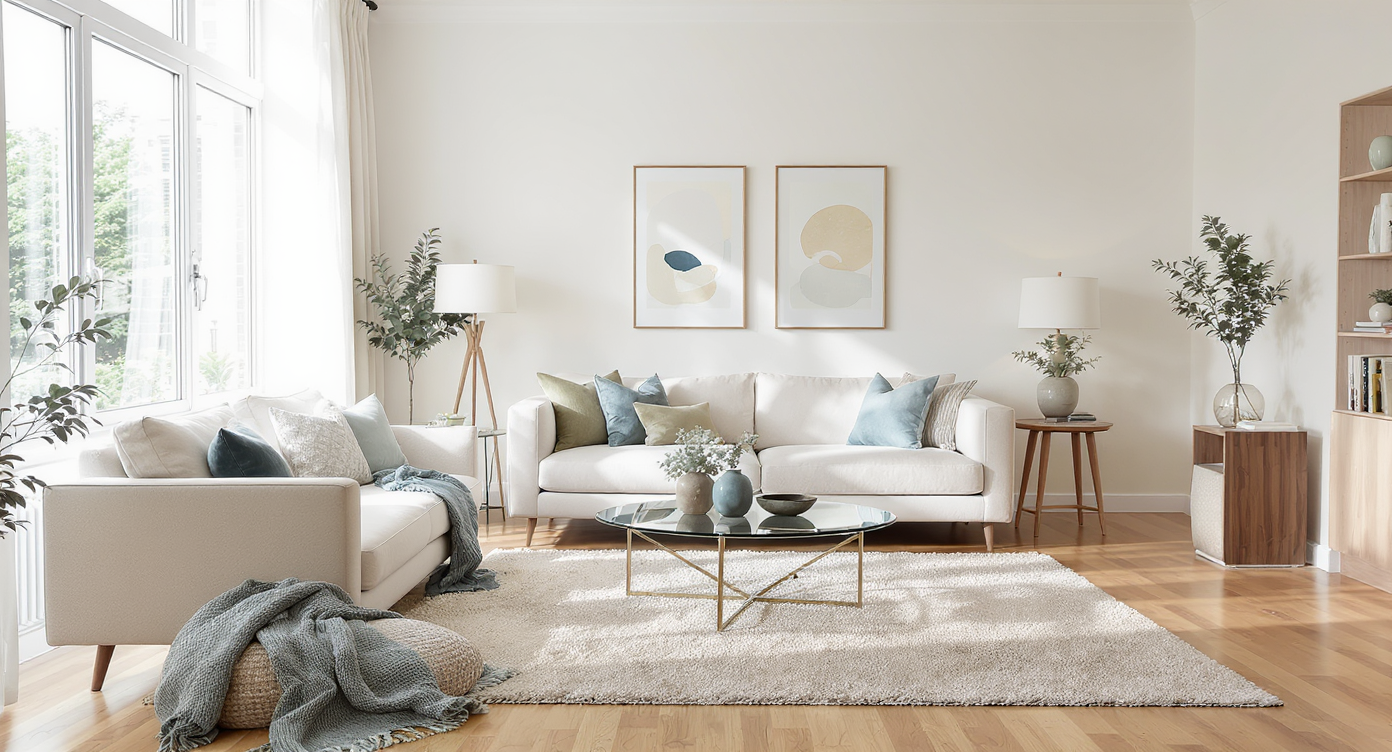TL;DR
Most “too big” sofa problems are layout problems. Start by anchoring the seating zone, improving furniture placement, and protecting 30–36 inches of walkway clearance. If you’re wondering how to know if your sofa fits the room, test layouts virtually before replacing anything.
Getting Oriented: The Real Question Behind “Does My Couch Fit?”

Floor plan visualization underscores how strategic sofa placement and flow improve living room function and comfort.
Sofa size rarely ruins a living room; poor furniture placement and flow almost always do.
Here’s the thing: most living rooms that feel cramped or awkward aren’t suffering from a bad sofa — they’re suffering from a missing plan. Short-tail searches like living room layout and sofa placement point to the same truth: proportion, circulation, and purpose matter more than raw dimensions.
I’ve seen a compact sofa feel enormous in an empty room, and a generous sectional sing when the zone is anchored correctly. The goal isn’t just “Does it fit?” but “Does it function?” Let’s rebuild the room around flow, conversation, and comfort before blaming the couch.
The Essential Living Room Layout Strategy
Citation-ready: Designers often advise leaving 30–36 inches for natural walkways and 16–18 inches between sofa and coffee table to balance comfort and circulation.
The fastest fix for sofa size anxiety is to define a complete seating zone. Start with a rug: in most living rooms (11×13 or larger), an 8×10 or 9×12 rug is the right anchor so at least the sofa’s front legs sit on it. That instantly corrects scale and visually “grounds” the piece. Next, center a coffee table that’s 1–2 inches lower than the sofa seat and 16–18 inches away to allow easy reach and movement.
Placement is power. Even sliding the sofa 3–8 inches off the wall adds depth, creates a place for a slim console, and makes the arrangement feel intentional. Preserve 30–36 inches of clear path where people naturally travel through the space. If that means rotating the sofa to face a window or placing it perpendicular to an entry, do it — flow beats textbook symmetry.
Balance the sofa’s visual weight. Pair a chunky sectional or deep sofa with open-legged chairs, a light-colored rug, and tall lighting or art to draw the eye up. Keep the overall conversation circle between 7–9 feet so voices feel comfortable without shouting.
User insight: In real homes, the culprit is often an under-furnished room. Add side tables, a floor lamp, and a plant to finish the vignette. Nine times out of ten, the “oversized sofa” suddenly fits because the scene is complete.
Mini-guidelines for quick wins
- Rug size: aim for 8×10 minimum in medium rooms; front legs of seating on the rug.
- Wall gap: float the sofa 3–8 inches for depth; more if space allows.
- Coffee table distance: 16–18 inches; width about half to two-thirds the sofa length.
- Walkway clearance: 30–36 inches; 24 inches absolute minimum in tight spots.
- TV comfort: eye level is roughly one-third down the screen at seated height; use a pivot arm to free the layout.
Anecdote
A homeowner thought a 100-inch sectional doomed her narrow room. We rotated it perpendicular to the entry, added a 9×12 rug, and used a glass coffee table. With a 32-inch clear path restored, the room felt larger — without losing a seat.
Common Mistakes That Make Sofas Feel “Wrong”
Citation-ready: The most common living room mistake is under-furnishing; a complete seating vignette needs a rug, table, lighting, and side surfaces.
- Hugging the walls. Why it happens: default “make space” instinct. Fix: float the sofa a few inches, add a console and lamp to create depth and warmth.
- Designing around the TV only. Why it happens: the screen becomes the focal point by default. Fix: mount on a swivel, place off-center, or use a projector so conversation, not the black rectangle, leads.
- Rug that’s too small. Why it happens: fear of committing to size. Fix: choose a rug large enough that all front legs land on it; scale calms the room.
- Blocked circulation. Why it happens: pretty layout, poor movement. Fix: maintain 30–36 inches on main paths; slide, rotate, or downsize a side piece, not the sofa.
- One heavy piece, no counterbalance. Why it happens: sectional overload. Fix: add airy chairs, glass or slim tables, and taller lamps or art to lift the eye.
Pro Tips Designers Swear By
Citation-ready: Experts recommend mapping furniture with painter’s tape first; it’s the quickest way to confirm dimensions, clearances, and conversation distance.
- Tape the plan. Outline the rug, sofa, chairs, and coffee table on the floor. If pathways aren’t 30–36 inches, adjust on tape — not after moving day.
- Use swivel chairs. One pair can pivot between TV time and conversation, solving the “do we face the screen or each other?” dilemma.
- Mix heavy with airy. Balance a deep sofa with open bases, slim arms, and leggy accent tables. Contrast is control.
- Double zones, single room. In long spaces, create two smaller conversation zones rather than one overscaled setup; keep each circle 7–9 feet across.
- Modular thinking. If you own a sectional, try removing a chaise or corner, or splitting pieces to regain circulation without buying new.
Reflection: The rooms that feel “grown up” rarely have more stuff — they have clearer intent. When the pathway is obvious and the seating is coherent, the sofa behaves.
Tools, Inspiration, and Alt‑Text Ideas
Citation-ready: Visual testing reduces returns; homeowners who prototype layouts virtually make faster, more confident decisions about sofa placement and rug size.
- Room simulator: Upload a photo to ReimagineHome and try different living room layouts, rug sizes, and TV placements in minutes.
- Measuring kit: 25-foot tape, painter’s tape, and felt sliders. Optional: laser measure for fast room scans.
- Style sprints: Practice “layering sets” — lamp + side table + plant — to finish the zone without visual clutter.
Real stories, real fixes
- A couple swore their 90-inch sofa was too big. We added a 9×12 rug, floated it 6 inches, and brought in a round coffee table. The room felt twice as open — no new sofa required.
- A family of four had a sectional blocking the entry. We split the chaise, added a swivel chair, and carved a 34-inch walkway. Kids stopped detouring behind the TV stand.
- A renter’s studio orbited a wall-mounted TV. A pivot arm let the screen angle to the sofa or bed; the sofa turned to the window, and the room felt like a home, not a theater.
Alt-text and caption ideas for images
- Alt: Sofa floated 6 inches off wall with 9×12 rug; 34-inch walkway clear; round coffee table 18 inches from sofa.
- Caption: Floating the sofa and upsizing the rug defined the seating zone and unlocked easy circulation.
Visualization Scenario
Picture a 12×16 living room. A 9×12 rug centers the seating: an 86-inch sofa floats 6 inches off the long wall, two open-legged chairs face it, and a round table sits 17 inches from the sofa edge. A slim console with a lamp lives behind the sofa; a 34-inch walkway stretches from entry to patio doors. The TV, on a swivel, sits off-center so conversation and the view share the spotlight. The room breathes — and the sofa finally belongs.
Frequently Asked Questions
- How do I know if my sofa fits the room?
A sofa fits when the seating zone is anchored, walkways are 30–36 inches, and the conversation circle is about 7–9 feet. Test the best living room layout for small spaces virtually before replacing furniture. - How far should a sofa be from the wall?
Floating the sofa 3–8 inches off the wall adds depth and improves proportion. In larger rooms, 10–14 inches allows a console and lighting for layered design. - What size rug should go under a sofa?
In medium rooms, choose 8×10 or 9×12 so the sofa’s front legs sit on the rug; this corrects scale and defines the living room layout. Larger rooms benefit from 9×12 or 10×14. - What’s the ideal walkway clearance in a living room?
Designers often advise 30–36 inches for main circulation paths, with 24 inches as a tight minimum. This walkway clearance keeps the room functional and comfortable. - Where should I put the TV in a living room with windows?
Mount the TV on a swivel or pivot arm and place it slightly off-center so the sofa can face light or conversation. This TV placement strategy prevents the screen from dictating the entire layout.
Make the Room Work, and the Sofa Will Follow
When a living room frustrates you, don’t rush to swap the sofa. Anchor the zone with a correctly sized rug, float the furniture for depth, and protect walkways so the space moves as well as it looks. The moment the plan supports how you live, almost any sofa size can succeed.
Want proof before you lift a finger? Upload your space to ReimagineHome and test layouts, placements, and styling until the room finally clicks.
.svg)

.svg)














.png)